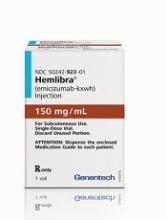GLASGOW—Final results from the HAVEN 3 study suggest emicizumab prophylaxis can reduce bleeding in hemophilia A patients without factor VIII inhibitors.
Compared to patients who did not receive prophylaxis, those who received emicizumab prophylaxis had a 96% to 97% reduction in treated bleeds and a 94% to 95% reduction in all bleeds.
An intra-patient comparison showed a 68% reduction in treated bleeds with once-weekly emicizumab, compared to prior factor VIII prophylaxis.
“[Emicizumab] is the first medicine to show superior efficacy to prior factor VIII prophylaxis, the current standard of care therapy, as demonstrated by a statistically significant reduction in treated bleeds in the HAVEN 3 study intra-patient comparison,” said Johnny Mahlangu, MB BCh, of the University of the Witwatersrand in Johannesburg, South Africa.
Dr Mahlangu presented these results at the World Federation of Hemophilia (WFH) 2018 World Congress during the late-breaking abstract session on Monday. HAVEN 3 was sponsored by Hoffmann-La Roche.
Patients and treatment
In this phase 3 trial, researchers evaluated emicizumab in patients with hemophilia A without factor VIII inhibitors. The study included 152 patients who were 12 years of age or older and were previously treated with factor VIII therapy on-demand or as prophylaxis.
Patients previously treated with on-demand factor VIII were randomized in a 2:2:1 fashion to receive:
- Emicizumab prophylaxis at 3 mg/kg/wk for 4 weeks, followed by 1.5 mg/kg/wk until the end of study (arm A, n=36)
- Emicizumab prophylaxis at 3 mg/kg/wk for 4 weeks, followed by 3 mg/kg/2wks for at least 24 weeks (arm B, n=35)
- No prophylaxis, only episodic/on-demand factor VIII treatment (arm C, n=18).
Patients previously treated with factor VIII prophylaxis received emicizumab prophylaxis at 3 mg/kg/wk for 4 weeks, followed by 1.5 mg/kg/wk until the end of study (arm D, n=63).
Episodic treatment of breakthrough bleeds with factor VIII therapy was allowed per protocol.
Emicizumab vs no prophylaxis
The model-based (negative binomial regression model) annualized bleeding rate (ABR) for treated bleeds was 1.5 in arm A, 1.3 in arm B, and 38.2 in arm C. The median ABR for treated bleeds was 0 in arms A and B and 40.4 in arm C.
Compared to patients in arm C, those in arm A had a 96% (P<0.0001) reduction in treated bleeds, and those in arm B had a 97% (P<0.0001) reduction in treated bleeds.
None of the patients in arm C had 0 treated bleeds, compared to 55.6% of patients in arm A and 60% of patients in arm B.
The model-based ABR for all bleeds was 2.5 in arm A, 2.6 in arm B, and 47.6 in arm C.
Patients in arm A had a 95% reduction in all bleeds (P<0.0001), and patients in arm B had a 94% reduction in all bleeds (P<0.0001), compared to patients in arm C.
Fifty percent of patients in arm A had 0 total bleeds, as did 40% of patients in arm B and 0% of patients in arm C.
Intra-patient comparison
The researchers compared previous prophylaxis to once-weekly emicizumab prophylaxis in 48 patients from arm D.
The model-based ABR for treated bleeds was 4.8 with prior prophylaxis and 1.5 with emicizumab. The median ABR for treated bleeds was 1.8 and 0.0, respectively.
Patients had a 68% reduction in treated bleeds with emicizumab (P<0.0001).
With prior prophylaxis, 39.6% of patients had 0 treated bleeds. With emicizumab, 54.2% of patients had 0 treated bleeds.
Safety
There were no serious adverse events (AEs) related to emicizumab, no anti-drug antibodies detected, and none of the patients on emicizumab developed de novo factor VIII inhibitors.
Injection-site reactions occurred in 25.3% of all patients (38/150), 25% of patients in arm A (9/36), 20% in arm B (7/35), 12.5% in arm C (2/16), and 31.7% in arm D (20/63).
An additional patient in arm D (who was included in the total) reported an “injection-site erythema,” not an “injection-site reaction.”
Upper respiratory tract infections occurred in 10.7% of all patients (n=16), 11.1% (n=4) of those in arm A, 11.4% (n=4) of those in arm B, 0% of those in arm C, and 12.7% (n=8) of those in arm D.
Other AEs occurring in at least 5% of patients were arthralgia (19%), nasopharyngitis (12%), headache (11%), and influenza (6%).
One patient in arm B discontinued emicizumab due to multiple mild AEs—insomnia, hair loss, nightmare, lethargy, depressed mood, headache, and pruritus.
Two patients were lost to follow-up—1 in arm A and 1 in arm C.


